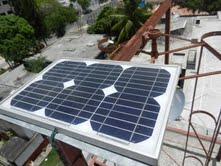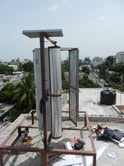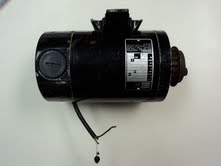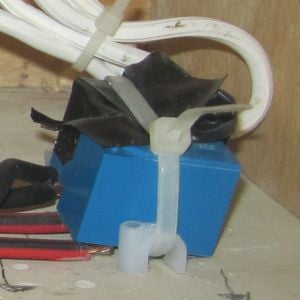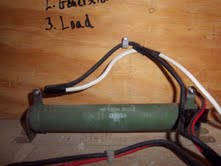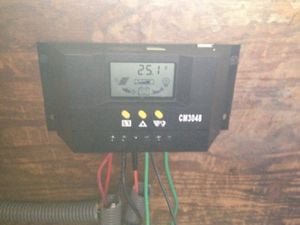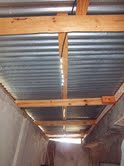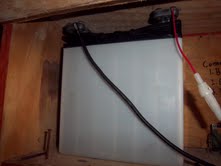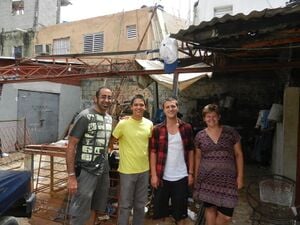
In the summer of 2012, Cal Poly Humboldt students returned to the Dominican Republic to improve the system to simplify the process of removing the system's rotating parts. With the help of UNIBE students and La Yuca community members, the wind turbine was upgraded to be more safe and efficient.
In 2011, the Cal Poly Humboldt Dominicana Program partnered with Universidad Iberoamericana (UNIBE), RevArk, and La Yuca community members to start the La Yuca small scale renewable energy. The objective of this project was to light the classroom that was built in the same year. However, the renewable energy system was not easy to remove in case of an emergency and did not generate the desired amount of energy. In the summer of 2012, Cal Poly Humboldt students returned to the Dominican Republic to improve the system to simplify the process of removing the system's rotating parts. With the help of UNIBE students and La Yuca community members, the wind turbine was upgraded to be more safe and efficient.
Objective[edit | edit source]
The objective of this project is to improve upon the previous summer's project. The turbine design will be altered so that it may be more efficient and safe. Energy generated by the system will be used to light a classroom in La Yuca.
Location[edit | edit source]
La Yuca del Naco, Santo Domingo, Dominican Republic
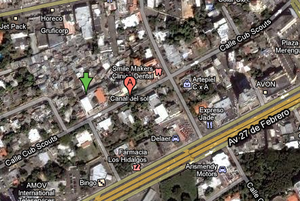
Criteria[edit | edit source]
After much team discussion, we decided what aspects of our project were most and least important. We will use these criteria to help us make decisions during the design and building process.
| Criteria | Weight | Description |
|---|---|---|
| Durability | 10 | Durability is the systems ability to withstand the elements and to continue working without needing to be replaced |
| Effectiveness | 10 | Effectiveness is how consistenly the system can deliver energy to the school |
| Safety | 7 | Safety is the ability of the system to not cause danger, risk, or injury |
| R&D Cost | 4 | Research and Developement Cost is how much money our group will spend to test, design, and develope a working system |
| Reconstruction Cost | 7 | Reconstruction cost is how much the system would cost if it was to be rebuilt using our specifications and design |
| Reproducibility | 8 | Reproducibility of the design is defined as the ability to which the design is able to be reproduced and marketed |
| Payback Time | 7 | Payback Time is the amount of time it would take for the system to generate the amount of energy that would cost the same as the system |
| Ease of Maintenance | 10 | Ease of Maintenance is a measure of how simple it is to protect the system from the elements and to repair it if it stops working |
| Aesthetics | 3 | Aesthetics is a measure of how pleasing the system looks |
Literature Review[edit | edit source]
Gearing[edit | edit source]
Gear systems use different sized gears to change the torque of a rotating object. Gear systems are used for bikes, cars, robotics, turbines, and a wide range of other objects.
Gear Ratios[edit | edit source]
A gear ratio is the relationship between two or more gears that are meshed together. Gear ratios are important parts of gearing systems because they make systems more efficient and precise. To find the optimum gear ratio between one or more gears, the number of gear teeth must be counted and compared. For example, if you had two gears, one with 16 teeth and another with 96, you would have a 1:6 gear ratio. A gear ratio of 1:6 means that for every one rotation of the larger gear, the smaller gear will rotate six times. When the larger gear rotates, the smaller gear will speed up to a faster RPM in order to maintain an identical rotational velocity as the larger gear.[1]
How to Care for Gears[edit | edit source]
Gear maintenance for a small scale wind turbine is similar to gear maintenance for a bicycle. Gears are usually made from metal, which may get rusty if they are exposed to moisture. If gears become rusted they may not rotate as well and may even lose their functionality. Gears can be lubricated to help prevent their degradation. There are numerous ways to lubricate gears with oil or other substances, which can increase their life by upto seven years.[1]
Climate[edit | edit source]
The Dominican Republic has a tropical climate in which elevation and trade winds bring an average annual temperature to 25oC, but the climate is a little different for Santo Domingo.
Temperature and Rain[edit | edit source]
In Santo Domingo the temperature is at a fairly constant and averages from 24-27oC. The annual monsoon rain season usually lasts from May to November. Santo Domingo has an annual average rainfall of 53 inches per year.[2]
Wind[edit | edit source]
Wind speeds in Santo Domingo range between 2.8 and 7 meters per second, and the average wind power is 24 watts per meter squared. The southern region of Santo Domingo has the largest wind resource due to incoming ocean winds. During a hurricane the surface winds can reach 105 knots and speeds of 140 mph.[3][4]
Hurricanes[edit | edit source]
The hurricane season for Santo Domingo lasts from June until November. Hurricanes usually move in the northwest direction from the Atlantic ocean through Santo Domingo along the coast line up to the northern coast. Hurricanes usually hit Santo Domingo from the southeast.[3][5]
Small Generators[edit | edit source]
Energy Production Variables[edit | edit source]
The wiring losses through small generators can reach up to 3-5%. Through a battery-based system there is often a 10% loss due to the need for a small trickle charge to maintain a float voltage, but one should never mix battery types. Inverters in small generators have an efficiency of approximately 85% for a battery-based system, and 90% efficiency for a battery-less system. The power density for small generators varies between the wind velocity and its power.[6]
- P is the total wind power
- ρ is the wind density
- V is the velocity
- A is the rotor swept area
Not all of the power in wind is usually available for useful work. According to the Betz Limit, the maximum wind power a turbine can extract is 59.3%. The decimal representation of this number is defined as the maximum power coefficient.[6]
Energy Calculations[edit | edit source]
Annual Energy Output (AEO)
or
Basic Parts of a Small Wind Electric System[edit | edit source]
There are several basic parts to a small wind electric system. These parts include a rotor, a generator to convert mechanical energy to electricity, wiring to transport electricity, controllers, inverters, and batteries.[7]
Wind Turbine[edit | edit source]
There are two main types of wind turbine, VAWTS(vertical axis wind turbine system) and HAWTS(horizontal axis wind turbine system). Most of the wind turbines that are manufactured today are horizontal axis turbines with two or three blades. The blades are usually made of fiberglass because it is a composite material. The amount of power that a turbine can produce is mostly determined by the diameter of the rotor in the system. The frame of the turbine includes a rotor, generator, and the blades that face into the wind.[7]
Tower[edit | edit source]
Wind speeds are known to increase with elevation, so turbines are usually mounted on towers. The greater the elevation of the turbine, the more power the system can produce. The more small investments to increase the tower height may also yield a very high rate of return of power production. Theoretically, if a 10-kW generator was raised from 60 feet to a height of 100 feet, there would be a 10% increase in the overall cost of the systems production and a 29% increase power production. There are two main types of wind turbine towers: self-supporting, and guyed. Guyed towers are mostly used for home power systems because they are the least expensive. Guyed towers usually consist of pipe or tubing, lattice sections, and supporting wires. Guyed towers are easier to install because the radius must be one-half to three-quarters of the tower height, in which guyed towers require enough space to accommodate them.[7]
Wire Sizing[edit | edit source]
Conductors[edit | edit source]
Wind power and battery systems often incorporate DC circuits and inverters for AC circuitry. AC and DC wiring systems should never be mixed in conduit, junction boxes, or raceways. DC systems are usually at low voltages which requires them to have a much larger wire size than the AC systems. Larger diameter wires are needed to minimize voltage drops.[8]
The polar environment introduces additional challenges in system wiring. Larger cables used for battery connections become incredibly stiff and difficult to work with due to the insulated sheathing. Coarse-stranded wire intended for residential AC-type use increases the difficulty. Pre-assembling as much of the system as possible will reduce field installation problems. However, installing battery cables and runs from the wind power system are often difficult to avoid. If wires are left to exposure to the environment, they must be rated for that exposure, including UV radiation. UV-resistant wiring is usually marked on the outside. Also, adapters should be included to bring your cables and conduit into junction boxes and enclosures. Every type of conduit, armored cable, or SO cord requires something a bit different.[8]
Grounding[edit | edit source]
Earth grounding must be done to every component enclosure, and bare metal frame. The earth ground must be connected to every metal electrical box or component enclosure, receptacle, and bare metal frame. Common practice includes grounding the turbine tower separate from the actual generator ground wire if the balance of the system is located far away from the tower. This is primarily for lightning protection, not a major concern in most polar environments but a possibility in some areas. All the ground rods should be connected with #4 bare copper and special ground-rod clamps.[9] All the ground wires should be tied in common and sent back to the primary earth ground, but only if the tower is within 100 feet of the balance-of-system components. The grounding wire is never fused or switched.[8]
Color Coding[edit | edit source]
Color Coding of Wire[10]
| DC Wiring | 120 AC Wiring |
|---|---|
| Red=Positive | Black=Hot |
| Black=Negative | White=Neutral |
| Green or Copper=Ground |
Rust[edit | edit source]
A problem that must be addressed is rusting of metallic parts. Rust is the result of oxidation of metal when it is exposed to moisture. Water acts as an electrolyte while steel gains oxygen molecules in chemical process called a redox reaction. The environment is a necessary component in the corrosion process which acts like an electrolyte when in contact with the metal.[11] This phenomenon can be a huge deterrence to any use of metallic devices over time. Metal exposed in the atmosphere is hard to completely protect from corrosion however there are preventative measures that can be taken to combat deteriorating metallic equipment. Methods in rust prevention include:[12][13]
- Choose products that are made of non-corrosive metals like stainless steel and aluminum.
- Metal Corrosion can be best controlled by maintaining a dry environment using suitable moisture barriers and drying agents.
- Remove any existing rust from the object before treating the metal to keep more from forming. Apply rust remover or scrub away rust with steel wool.
- Utilize cleaning agents like soaps, solvents, emulsion compounds and chemicals to efficiently get rid of oil, grease, dirt and other unwanted foreign deposits and follow the correct procedures in applying them.
- Make sure that electrical connections are clean.
- Apply primer to the metal with clean paintbrush, and then apply paint to protect it from corrosion.
- Allow the treatment to dry and apply a second coat if necessary.
- Galvanizing also provides metal corrosion protection. This is the process of giving a thin coating of zinc or steel material by immersing the object in a bath primarily composed of molten zinc. Galvanizing is an efficient way to protect steel because even if the surface is scratched, the zinc still protects the underlying layer.
Design[edit | edit source]
The solar and wind system built in 2011 was torn apart shortly after it was made because the turbine presented a danger when a hurricane came through. In 2012 the turbine was to be made more rain and hurricane proof, less susceptible to theft, and overall better capable of producing electricity.
To hurricane proof the system, it was necessary to alter the design so that the turbine could be stopped or removed easily. To accomplish this, the bolts that held the rotating part of the turbine were replaced by quick release bike bolts. With this design, the turbine can easily be removed and replaced without a tool.
The generator is not built to stand up to rain. To protect it from the rain, a plastic box was built that covers the generator and still lets the chain run to it.
Last year, the wires that connected the turbine to the school hung across the roof the turbine was on, then down to the school. They were easily stolen. This year, a cable was run around the building, and put it in conduit to protect it.
To make the turbine produce more, usable electricity, we had to work with the gear ratio on the turbine. Before, a chain ran straight from the turbine to the generator. Now, two chains connect to a gear tree to make the gear ratio higher and spin the generator faster.
With the generator running faster than last year, it's more important to have extra precautions on the electrical system. The system was rewired with more diodes and fuses to stop components from overloading.
Electronics[edit | edit source]
During the day the solar panel has the ability to generate up to 10W. The wind turbine has the ability to produce about 30W. They are both intermittent energy sources that compliment each other or run in tandem depending on the weather. This design was intended for having optimal charging time for the battery bank.
The new path of the wire is twice as long as last year's wire. It was made longer because the client requested that the wire run around the edge of the roof before running down to the school's battery station. As a result the gauge of wire was increased to 10 gauge to increase safety and reduce resistance in the electrical current being transmitted.
The electric energy from the solar panel and turbine generator is direct current. In this system a 1-amp diode was placed on the positive line from the solar panel and a 6-amp diode was placed on the positive line from the turbine generator. Additionally a 2-amp fuse was placed on the positive line from the turbine to prevent energy spikes from the wind turbine. A fuse was omitted on the positive line from the solar panel because the maximum power output (10W) was not considered a hazard to the system.
The combined electrical power is then transmitted to the relay in the battery station that takes any excess energy (24+ volts) to a shunt resistor to prevent energy surges from damaging the system. A shunt resistor is a coil of wire that turns electric energy into heat energy, expending the excess energy diverted by the relay.
The energy that is less than 24 volts goes to the charge controller. The charge controller, among other functions, regulates battery's voltage. The model being used is an ERPC-5 pulse width modulator (PWM). It has the ability to switch the circuit off automatically if the circuit is overloaded with voltage. The charge controller includes 16 digital LED lighting options, number display, digital LED stop flash to confirm correct switch selection, manual test capability, automatic timer, and can detect day and night using the PV array. The charge controller has three pairs of inputs, which are for the battery, the incoming energy (the solar panel and generator), and the outgoing energy (the lights). In this system the mode is set to "6" which runs the controller without any automatic lighting control or timers.
The direct current is connected to the battery with an 8-amp fuse in between. The fuse is precautionary in case of a spike in amperage. When given enough power from the energy sources, the charge controller is able to regulate battery voltage and keep a full charge. The energy from the system is used to power twenty-one 12V LEDs in parallel, which is in line with an on/off switch and a 4-amp fuse. The lights are mounted to the ceiling, and provide ample light to the small classroom.
The battery station is located in a wooden box mounted in the classroom near the entrance. It contains the relay, shunt, charge controller, and battery.
Materials Used[edit | edit source]
- Solar panel
- Metal turbine frame
- Newspaper panels
- Gears
- Motor
- Plastic box
- Cable
- Conduit
- Fuses
- Diodes
- Switches
- Relay
- Shunt
- Charge controller
- Battery
- LED lights
Components[edit | edit source]
Payback Time[edit | edit source]
To calculate payback time, We came up with this equation:
Where:
- T is the payback time in years
- Ct is the total cost of the system
- Ce is the cost of energy per kWh
- Pe is the energy produced every day
- 365 is a multiplier to turn days into years
For this equation, we calculated that our total system cost is RD$15,200. We estimated that our energy costs are US$0.136 per kWh[14] (or about RD$4.964), and that our power output is 0.1 kWh per day. With these numbers, the time it would take to pay back the system is about 76.5 years.
Timeline[edit | edit source]

Discussion[edit | edit source]
Obstacles[edit | edit source]
One of the biggest obstacles faced while working on the project was the unavailability of power. The power was often off completely during the otherwise most convenient hours to work, and when it was on, it was unreliable due to strength of the current through the extension cord.
Another obstacle faced while working, but didn't notice for a while, is that the gear placed under the turbine was off centered. This caused the chain to tighten and loosen while spinning, either giving too much resistance for it to spin the gears fast enough, or making the chain loose enough to fall off.
Our last obstacle faced was the wind speeds during our work hours. The low wind speeds made it very difficult to test how much energy our system could produce on a day with strong winds. The uncentered gear also made it harder to determine how well the system could spin in the wind because the extra resistance slowed it down.
Next Steps[edit | edit source]
The next step for this system would be to reduce the friction that is occurring in the gears. Reducing this friction would allow less wind to spin the turbine, making it easier to give more power to the classroom below. Increasing the efficiency would also reduce the payback time.
Reducing the friction can be done by getting a generator that is a better size for the system.
Another important part of improving the system would be to get more data. By using an anemometer to measure the wind and a multimeter to measure current and voltage, we could find what wind speeds and what gear ratios produce the most, useable energy.
References[edit | edit source]
- ↑ 1.0 1.1 <"Wind Energy Math Calculations Gear Ratios".pdf http://web.archive.org/web/20150924084336/http://www.mmpa.org/Uploaded_Files/93/93934e74-9b35-4566-b5b4-dad8816fed46.pdf>
- ↑ <"Weather of the Dominican Republic." Dominican Republic Weather. N.p., n.d. Web. 16 July 2012. http://web.archive.org/web/20140322170423/http://dominicanrepublic-guide.info/weather/>
- ↑ 3.0 3.1 <"Wind Energy Resource Atlas of the Dominican Republic." N.p., n.d. Web. http://www.nrel.gov/docs/fy02osti/27602.pdf>
- ↑ <"Hurricane Beulah." U.S. Department of Environmental Science $.Weather Bureau Commerce Services Administration. N.p., 7 Sept. 1967. Web.>
- ↑ <"Preliminary Report Hurricane Georges 15 September - 01 October 1998." TPC ATLANTIC GEORGES 1998 PRELIMINARY REPORT. N.p., n.d. Web. 16 July 2012 http://web.archive.org/web/20140603203950/http://www.nhc.noaa.gov:80/1998georges.html>
- ↑ 6.0 6.1 <"Small Wind." N.p., 2009. Web. June 2012.>
- ↑ 7.0 7.1 7.2 <"Small Wind Electric Systems." Energy Efficiency and Renewable Energy. U.S. Department of Energy, n.d. Web. >
- ↑ 8.0 8.1 8.2 <Dahl, Tracy. "Wind Power Systems." Polar Power. Technology White Power, n.d. Web. June 2012. http://web.archive.org/web/20151106112314/http://www.polarpower.org:80/static/docs/WindPower05Apr06.pdf>
- ↑ <Dahl, Tracy. "Wind Power Systems." Polar Power. Technology White Power, n.d. Web. June 2012. http://web.archive.org/web/20151106112314/http://www.polarpower.org:80/static/docs/WindPower05Apr06.pdf>
- ↑ <"Video:Identify Electrical Wire Color Coding." About.com. N.p., n.d. Web. June 2012. http://video.about.com/electrical/Identify-Wire-Color-Coding.htm>
- ↑ <Bardal, E. (2004). "Corrosion and protection" London: Engineering Materials and Processes. Springer, London>
- ↑ < Smith & Arrow, (2010). "10 Ways to Prevent Metal Corrosion", http://www.smithandarrow.com.au/blog/rust-corrossion/10-ways-prevent-corrosion-metals/ (June 9, 2012)>
- ↑ <Russell, Milenna, (2012). "How to Prevent Rust" eHow, <http://web.archive.org/web/20170622004008/http://www.ehow.com/how_5148599_prevent-rust.html> (June 9, 2012).>
- ↑ "Electricity Prices for Households." Energy Information Administration, 10 June 2010. Web. 9 Sept. 2011. <http://www.eia.gov/emeu/international/elecprih.html>.



